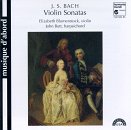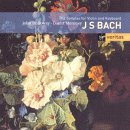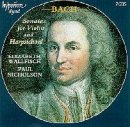|
Sonatas for Violin & Harpsichord BWV 1014-1019
Bach's Sonatas for Violin & Harpsichord
Contents
Recordings
Part 1
Part 2
Part 3
Part 4
Part 5
Part 6
Part 7
Recordings
|
1 |
Sonatas for Violin and Harpsichord |

|
|
Sonatas for Violin and Harpsichord BWV 1014-1019 |
|
Rachel Podger/Trevor Pinnock |
|
Channel Classics |
2000 |
2-CD / TT: 2:18:53 |
|
2 |
Sonatas for Violin and Harpsichord |

|
|
Sonatas for Violin and Harpsichord BWV 1014-1019 |
|
Reinhard Goebel/Robert Hill |
|
Archiv |
1981-1983 |
2-CD |
|
3 |
Sonatas for Violin and Harpsichord |

|
|
Sonatas for Violin and Harpsichord BWV 1014-1019 |
|
Sigiswald Kuijken/Gustav Leonhardt |
|
DHM |
1973 |
2-CD |
|
4 |
Sonatas for Violin and Harpsichord |

|
|
Sonatas for Violin and Harpsichord BWV 1014-1019 |
|
Elizabeth Blumenstock/John Butt |
|
Harmonia Mundi |
1991-1992 |
2-CD |
|
5 |
Sonatas for Violin and Harpsichord |

|
|
Sonatas for Violin and Harpsichord BWV 1014-1019 |
|
Ryo Terakado/Siebe Henstra |
|
Denon |
1996 |
2-CD / TT: 1:50:47 |
|
6 |
Sonatas for Violin and Harpsichord |

|
|
Sonatas for Violin and Harpsichord BWV 1014-1019 |
|
Catherine Mackintosh/Maggie Cole |
|
Chandos |
1995-1996 |
2-CD |
|
7 |
Sonatas for Violin and Harpsichord |

|
|
Sonatas for Violin and Harpsichord BWV 1014-1019 |
|
Andrew Manze/Richard Egarr |
|
Harmonia Mundi |
1999 |
2-CD |
|
8 |
Sonatas for Violin and Harpsichord |

|
|
Sonatas for Violin and Harpsichord BWV 1014-1019 |
|
Fabio Biondi/Rinaldo Alessandrini |
|
Opus 111 |
1995 |
2-CD |
|
9 |
Sonatas for Violin and Harpsichord |

|
|
Sonatas for Violin and Harpsichord BWV 1014-1019 |
|
John Holloway/Davitt Moroney |
|
Virgin |
1988 |
2-CD |
|
10 |
Sonatas for Violin and Harpsichord |

|
|
Sonatas for Violin and Harpsichord BWV 1014-1019 |
|
Marianne Ronez/Ernst Kubitschek |
|
Winter & Winter |
1999 |
2-CD |
|
11 |
Sonatas for Violin and Harpsichord |

|
|
Sonatas for Violin and Harpsichord BWV 1014-1019 |
|
Lucy van Dael/Bob van Asperen |
|
Naxos |
1999 |
2-CD |
|
12 |
Sonatas for Violin and Harpsichord |
|
|
Sonatas for Violin and Harpsichord BWV 1014-1019 |
|
Monica Huggett/Ton Koopman |
|
Philips |
1983 |
2-CD |
|
13 |
Sonatas for Violin and Harpsichord |

|
|
Sonatas for Violin and Harpsichord BWV 1014-1019 |
|
Jaap Schröder/Helga Ingolfsdottir |
|
AC Classics |
1999 |
2-CD |
|
14 |
Sonatas for Violin and Harpsichord |

|
|
Sonatas for Violin and Harpsichord BWV 1014-1019 |
|
Elizabeth Wallfisch/Paul Nicholson |
|
Hyperion |
1996 |
2-CD |
Part 1
Donald Satz wrote (January 15, 2001):
Many of Bach's works require a highly concentrated and demanding listening regimen to experience all the rewards inherent in his music: Art of Fugue, Solo Cello Suites, Musical Offering, etc. Of course, there is another side to Bach where he gives us immediately accessible music as with the Brandenburg Concertos and Orchestral Suites. The Sonatas for Violin & Harpsichord, BWV 1014-1019, are in this latter category. They are alternately lovely/sad and exciting works. Except for BWV 1019, their movements are in the slow-fast-slow-fast sequence.
I am reviewing fourteen period instrument sets. I find the baroque violin the perfect stringed instrument for this repertoire. No modern string versions are included solely based on my preferences.
Most of the sets include other works of Bach, because the six sonatas mandate more than one disc but less than two. Two Sonatas for Violin and Bass continuo, BWV 1021 & 1023, are common fillers in the sets. Some of them also have other Bach compositions. Once finished reviewing the six Sonatas for Violin & Harpsichord, I will go through these additional works.
The sets being reviewed are:
[1] Rachel Podger/Trevor Pinnock - Channel Classics 14798 (2000).
[2] Reinhard Goebel/Robert Hill - Archiv 427152 (1981-83).
[3] Sigiswald Kuijken/Gustav Leonhardt - DHM 77170 (1973).
[4] Elizabeth Blumenstock/John Butt - Harmonia Mundi 907084/85 (1991/92).
[5] Ryo Terakado/Siebe Henstra - Denon 18029/30 (1996).
[6] Catherine Mackintosh/Maggie Cole - Chandos 0603 (1995/96).
[7] Andrew Manze/Richard Egarr - Harmonia Mundi 907250/51 (1999).
[8] Fabio Biondi/Rinaldo Alessandrini - Opus 111 30-127/28 (1995).
[9] John Holloway/Davitt Moroney - Virgin 90741 (1988).
[10] Marianne Ronez/Ernst Kubitschek - Winter & Winter 910047 (1999).
[11] Lucy van Dael/Bob van Asperen - Naxos 8554614 & 8554783 (1999).
[12] Monica Huggett/Ton Koopman - Philips 410401 (1983).
[13] Jaap Schröder/Helga Ingolfsdottir - AC Classics 99071 (1999).
[14] Elizabeth Wallfisch/Paul Nicholson - Hyperion 22025 (1996).
I am very enthusiastic concering this review project because of the music and the list of wonderful period instrument artists performing on these versions. There are no artist duplications, although that will come up concerning continuo support in a few versions.
BWV 1014 in B minor - The opening Adagio begins with just the harpsichord, then the violin enters in a hushed tone and long line which slowly increases in volume until it is an equal and particularly pungent partner with the harpsichord. It's a fantastic beginning and hooks me every time. The music is sad to the core and pulls me into its complete melancholy. The imagery is of the collapse of spirit and the effort of the violin to ward it off. Toward the conclusion, the violin releases a tremendous blast of energy which represents the last gasp. This can be a high impact piece of music if certain performance aspects are observed, and most of them have to come from the violin. Specifically, the violinist has to immerse him/herself into the bottom of human despair, attempt one last time to rise with pride, and accept defeat. In reviewing this movement, I find that the performances either "get it or they don't".
Lucy van Dael doesn't get it. Yes, it's a lovely performance all around. But where is the sadness, the explosion of energy, the abject acceptance of defeat? Well, it's all at a minimum, and that's not good. Listen to Holloway or Blumenstock; whether you agree with my preferences or not, I'm sure you will notice a large difference in expressiveness.
Ronez/Kubitschek have two problems; Ronez is low on tonal beauty compared to most other versions, and Kubitschek's playing is rather earth-bound. They do surpass Biondi's reading which is very fast: three mintues instead of the average of close to four minutes. The result is less weight, and Biondi's occasional romantic affectations don't help matters.
The Andrew Manze version uses the gamba for continuo purposes. I'd like to tell you that it's a fine addition, but I have other thoughts. This gamba, played by Jaap ter Linden, overwhelms the harpsichord and throws the balances off center. Also, Manze, who is outstanding in some passages, has a penchant for going 'soft'; when he does, the balances are even more distorted.
The harpsichord sets the foundation and rhythm for the Adagio, and Paul Nicholson's rhythm is somewhat staid. His partner, Elizabeth Wallfisch, is generally excellent but the staid effect hits her a few times as well. Kuijken/Leonhardt are a little disappointing; Kuijken is sometimes too demure and Leonhardt not sufficiently angular.
Podger, Schröder, Huggett, and Mackintosh give excellent performances. Huggett's partner, Koopman, is particularly note-worthy with some enchanting ornamentation.
Goebel and Terakado deliver outstanding readings. They consistently dig for the music's core, balance excellently with the harpsichord, and convey strong conversations between the voices.
The Adagio's magic comes from Holloway/Moroney and Blumenstock/Butt. The Holloway version has a majesty beyond compare, and Moroney has an irresistable hesitation in his delivery. Blumenstock's release of energy toward the end just has to be heard; it pierces the heart. Butt provides the most interesting performance on harpsichord, an interpretation I would have expected from Leonhardt.
The second movement Allegro thrives on contrapuntal energy and is exciting and lyrical music. I really have no complaints about any of the fourversions; each one well provides the basics. Five do better than that. Biondi has a nice sweet tone, and Alessandrini is wonderful in his accenting and projection. Mackintosh/Cole is notable for Maggie Cole's incisive playing. Huggett provides the greatest tonal beauty without foresaking any excitement.
The special versions are van Dael/van Asperen and Blumenstock/Butt. Each pair is in perfect unison with one another. Blumenstock's version is perpetual motion and the most exciting reviewed. van Asperen provides the best rhythm and foundation; van Dael is right in step with him.
The third movement Andante is bitter/sweet music of great poignancy. Biondi, as in the first movement, is on the quick side with a lovely but surface-bound reading. In comparison, Goebel and Manze are very expressive.
However, both do drag a little. Although perhaps a little too quick, both Mackintosh and Cole perform beautifully and in perfect unison. Ronez is as fast as Biondi but not as tonally attractive. Terakado's version is the slowest of the group, and there is an element of wallowing in pathos. van Dael, as in the first movement, is not as expressive as I would like. Wallfisch and Nicholson provide the fastest version; they almost make the movement playful and whimsical. I think the interpretation sends very mixed messages and is the least rewarding of all the performances.
The above eight versions are each highly enjoyable. The excellent versions have the added advantage of superior conversation: Holloway and Moroney, Kuijken and particularly Leonhardt, Podger and Pinnock. Outstanding versions come from Schröder/Ingolfsdottir, Huggett/Koopman, and Blumenstock/Butt. These three have all the favorable elements of the other performances plus a blend of relaxation and animation that's absolutely mesmerizing among the three voices.
The last movement, Allegro, introduces a foreboding danger to the Sonata in B minor. All versions capture this essential element very well. Fine performances come from van Dael, Goebel, Ronez, Terakado, Holloway, Podger, Mackintosh, Manze, and Wallfisch. Manze would have been excellent except for the interference from the gamba. The excellent versions, displaying a more intimate partership of violin and harpsichord, are Schröder, Biondi, Kuijken, and Blumenstock.
There's one version that greatly ups the danger level in the second theme - Huggett and Koopman. In addition to increasing the heart beat, they provide the Allegro with a progression that the other versions can't match.
Summary for Sonata in B minor:
Elizabeth Blumenstock and John Butt easily provide my favorite version. They are constantly excellent and often magical. Their partnership is outstanding, and Blumenstock has been more expressive than any other violinist. Their B minor performance is a treasure.
Monica Huggett and Ton Koopman are next. As with Blumenstock, Huggett has been consistent and her tonal beauty is second to none. Their second theme from the fourth movement is revelatory. The third rung finds Holloway and Schröder. I find it interesting that Holloway does much better in the slow movements; in fact, he's superb.
Very good performances come from van Dael, Kuijken, Podger, Mackintosh, Goebel, and Terakado. Among the remaining versions, Manze's use of the gamba for continuo effect is not to my liking; it damages balance, does not sound attractive, and makes the harpsichord a distant cousin. Ronez has a problem with tonal beauty; her violin just doesn't sound very good. Wallfisch is at the bottom largely due to her partner Paul Nicholson who is adding little to the interpretations and not operating on an equal footing.
The partnership aspects of performing Bach's Sonatas for Violin & Harpsichord is so important. To be distinctive and in unison is no easy task. So far, I'm finding that the different versions are much better at conveying the emotional core of the music than in displaying the blend of distinction and unity from the two performers which is essential in providing outstanding music-making.
Continue on Part 2
Sonatas for Violin & Harpsichord BWV 1014-1019 : Part 1 | Part 2 | Part 3 | Part 4 | Part 5 | Part 6 | Part 7 | Carmignola & Marcon | Comberti & Tilney | Ngai & Watchorn (Satz) | Ngai & Watchorn (McElhearn) | Ronez & Kubitschek | Standage & Ad-El
|